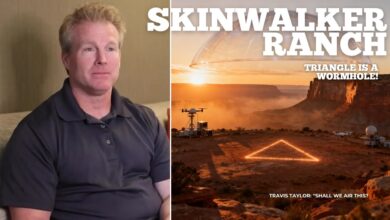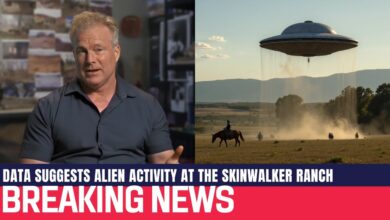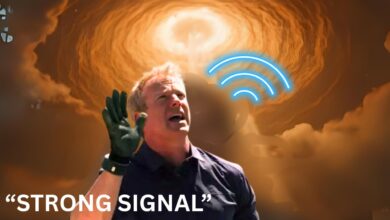Travis Taylor and Team made a TERRIFYING Discovery (Skinwalker Ranch)
Travis Taylor and Team made a TERRIFYING Discovery (Skinwalker Ranch)

“Can you look up—it does go into a cone at that—it is a cone! Wow! I mean, that is insane. We’ll put our heads together. This is amazing. It’s going to take me a while to get my head around this, to process what I’ve just been shown. I don’t know what it is, but there had to be something there for the LIDAR to detect it. And we made something nobody has ever seen before. Period. Ever.”
Inspired by ancient Native American legends of portals and gateways at Skinwalker Ranch, Dr. Travis Taylor and his dedicated team embark on a daring experiment in the East Field near the enigmatic Mesa.
Stories of strange phenomena and unexplained events have long shrouded this area in mystery, fueling their determination to uncover the truth.
Equipped with cutting-edge technology, their plan involves transmitting a 1.6 GHz signal directly into the heart of the anomaly—a suspected hotbed of unexplained activity.
This signal, carefully chosen for its potential to interact with hidden forces, could reveal something extraordinary.
But the stakes are even higher: by launching a rocket into the suspected anomaly, they hope to provoke a reaction and capture groundbreaking data—perhaps even a visual image of what lies beyond the known.
The team’s efforts are not merely an attempt to gather evidence; they represent a bold step toward solving the mysteries that have puzzled scientists, skeptics, and enthusiasts for decades.
Could something monumental lie beneath the Mesa, concealed from human understanding?
Is it possible that these efforts will unlock the secrets of interdimensional portals—or other phenomena that defy the laws of physics?
Join us as we follow Dr. Taylor and his team through this high-stakes journey into the unknown, where science meets the supernatural.
The astonishing discoveries they make could redefine not only the story of Skinwalker Ranch, but our entire understanding of the universe itself.
For decades, explorers, scientists, and skeptics alike have been drawn to the haunting allure of Skinwalker Ranch, striving to unravel the secrets buried deep beneath its surface.
Tales of portals, otherworldly beings, and inexplicable phenomena have inspired countless expeditions—yet none have fully uncovered the truth.
Now, Dr. Travis Taylor and his team are venturing where no one else has dared to go.
They’re not just scratching the surface; they’re delving into uncharted depths.
Equipped with cutting-edge technology and an unrelenting drive to solve mysteries that have eluded humanity for generations, the anticipation is palpable as the team approaches the Mesa—a towering geological feature that many believe holds the key to the ranch’s most baffling phenomena.
The air is thick with a mixture of excitement and trepidation, each member acutely aware that an alien encounter—or perhaps evidence of something even stranger—might be just within reach.
What secrets could be hidden beneath this ancient land?
Could the legendary stories passed down through generations hold more truth than anyone imagined?
As they begin to set up their equipment, the team knows this isn’t just another routine scientific experiment; this is a historic attempt to blend rigorous science with the enigmatic folklore that surrounds the ranch.
Central to their mission is Travis’s calculated choice of a 1.6 GHz signal.
This frequency wasn’t selected at random—it’s a precise and deliberate effort to probe what might be an invisible barrier or anomaly linked to the countless unexplained events in the area.
By transmitting this signal directly into the suspected hotspot, the team hopes to provoke a response—perhaps even an interaction with forces beyond our understanding.
The equipment they’ve brought reflects their ambitious goals:
ground-penetrating radar to map what lies beneath, electromagnetic sensors to detect fluctuations, and high-resolution cameras to capture anything that might manifest.
The rocket launch—meticulously planned to pierce the suspected anomaly—is a bold move designed to provoke a measurable reaction.
What if the anomaly reacts violently?
What if it reveals something entirely unprecedented—something that could change our understanding of reality itself?
As the experiment commences, the tension rises.
The whirring of machinery, the hum of the signal, and the concentrated focus of the team create a charged atmosphere.
This isn’t just about detecting any signal or anomaly—it’s about unlocking the mysteries of a place that defies the boundaries of conventional science.
Every beep of the equipment, every flicker on the monitors, holds the promise of discovery.
Could the team be on the brink of confirming that the legends are true?
Will they find evidence of portals, hidden technologies, or perhaps a presence not of this Earth?
With every passing second, the possibility grows that this experiment could yield a breakthrough that redefines humanity’s place in the cosmos.
One thing is certain: the discoveries made here will resonate far beyond the Mesa—challenging what we think we know and opening doors to questions we’ve only begun to ask.
As the team delves into the mysterious regions beneath the Mesa, they begin to encounter a series of peculiar phenomena that have persisted since the previous year.
Among these was the discovery of an enigmatic aerial anomaly above the flat-topped hill known as the Mesa.
Intriguingly, this area lies directly above an ancient rock carving—a symbol or message that has intrigued historians and archaeologists for decades, hinting at the significance of the site.
Spurred by these events, the team devised a daring experiment to test an extraordinary hypothesis.
Their plan centered on two key individuals, each tasked with a crucial role.
One member positioned themselves at the location where the strange phenomenon was initially observed, equipped with a powerful radio transmitter capable of emitting signals through the dense rock.
Meanwhile, at the other end of the Mesa, Eric took up his station at the spot where the phenomenon was last seen ascending into the sky, armed with an ultra-sensitive receiver.
Eric prepared to capture any signals that might somehow traverse the seemingly impenetrable rock barrier.
Under normal circumstances, radio signals cannot penetrate such a solid mass.
However, the experiment’s purpose was to explore the possibility of an unknown passage within the Mesa—a hidden tunnel, an unexplored geological feature, or something even more extraordinary.
Could this barrier conceal a dimensional portal, as some have speculated?
The implications of such a discovery would be staggering—rewriting the boundaries of science and reshaping humanity’s understanding of the natural world.
Despite the seemingly improbable nature of their goal, the team pressed forward with a mix of scientific rigor and open-minded determination.
Every moment carried the weight of possibility.
If Eric received a signal, it could mean that the Mesa harbors a secret passage—or an unexplained phenomenon capable of defying known physical laws.
As they conducted the experiment, the tension mounted.
Was the Mesa merely a geological formation, or was it something more—an ancient gateway, a natural anomaly, or a construct with origins yet to be understood?
The team’s exploration was not only a quest for answers but also a testament to the enduring human desire to push the boundaries of knowledge, even when the truth seems unbelievable.
The possibility of uncovering a hidden passageway or unexplained phenomenon within the Mesa’s solid rock was undeniably thrilling—even if met with skepticism by some.
If a signal could pass through the seemingly impenetrable barrier, it would be a groundbreaking discovery—one that could fundamentally alter our understanding of what lies beneath this enigmatic formation.
With this goal in mind, the team approached the experiment with meticulous care, determined to leave no room for doubt.
They began by thoroughly testing all their equipment.
Eric meticulously calibrated his sensitive receiver, ensuring it was precise enough to detect even the faintest signal.
Meanwhile, his colleague at the transmitter conducted rigorous tests—adjusting signal strength and testing angles to maximize the chances of success.
This phase was critical, as any technical issues could compromise the entire experiment and obscure its results.
After verifying that everything was functioning flawlessly, the team moved on to the main experiment.
The air was thick with both excitement and suspense as they prepared to transmit the signal.
The question loomed large: could Eric’s receiver pick up even a faint transmission from the other side of the Mesa?
A positive result would challenge existing scientific principles, suggesting the presence of an unknown passage, tunnel, or perhaps something far more extraordinary—an anomaly defying conventional understanding.
The experiment wasn’t just about testing the permeability of the rock.
It was a bold step toward uncovering the secrets of the Mesa.
Even if the signal failed to pass through, the process itself would yield invaluable data.
But if the signal succeeded, the implications would be monumental—opening doors to new theories about the structure of the Mesa, its potential connection to ancient legends, and the nature of the unexplained phenomena reported in the area.
As the team stood at the threshold of discovery, they understood that this was only the beginning.
Whether the experiment confirmed their hypothesis or not, the knowledge gained would push the boundaries of their understanding.
With the first signal transmitted and all eyes on Eric’s receiver, they braced themselves for what might be a defining moment—not just for their investigation, but for the broader quest to unravel the mysteries of Skinwalker Ranch.
The mysteries of the Mesa, coupled with the strange sightings above it, had drawn the team into uncharted territory.
Their experiment had the potential to reveal something extraordinary — a hidden passage, an anomaly, or perhaps a portal — or simply confirm that the natural rock barriers were as impenetrable as they seemed.
Either way, the endeavor promised to yield valuable insights into the enigmatic Mesa.
The team hummed with anticipation as they finalized their setup.
The transmitter and receiver were carefully positioned at their designated spots, and every detail of the experiment was reviewed to ensure precision.
Adding another layer of sophistication to their investigation, team member Jim Royston prepared to launch a high-tech drone outfitted with LIDAR and GPS systems.
This drone, programmed to maintain a steady altitude of 300 ft, would provide a comprehensive aerial perspective of the Mesa — capturing high-resolution images and gathering crucial data to complement the experiment below.
The flight was supposed to be routine.
Eric took charge of monitoring the drone’s path, ensuring it followed its pre-programmed route without deviation.
Jim, a seasoned operator with extensive experience in drone missions, had confidence in the drone’s capabilities and in the team’s meticulous planning.
Everything was ready, and the drone ascended smoothly, its cameras trained on the rugged terrain below.
At first, the session seemed uneventful.
The drone transmitted stunning images of the untouched landscape — a bird’s-eye view of the Mesa’s mysterious contours.
The team anticipated a straightforward operation: valuable data collection coupled with spectacular visuals.
But then, the unexpected happened.
The drone’s automated systems — designed to handle emergencies and prevent errors — suddenly triggered a “return to home” command.
This abrupt change was both unusual and alarming.
The drone’s sensors should have detected no issues, and its flight path had been programmed with exacting care.
Yet without warning, it began to retreat from its route, disrupting the carefully planned experiment.
The team scrambled to understand what had gone wrong.
Was it a technical glitch, or had the drone encountered something beyond their understanding?
The Mesa, already shrouded in mystery, seemed to resist their efforts to probe its secrets.
The disruption heightened the tension, reminding everyone that this was no ordinary investigation.
As the drone descended, the team reviewed its data, hoping to find clues about the sudden system override.
Was there interference — a signal or force they couldn’t yet explain?
This unplanned event added a new layer of intrigue to their exploration.
What had caused the drone systems to malfunction, and could it be connected to the strange phenomena they had observed above the Mesa?
Though their plans had been disrupted, the team’s resolve only deepened.
The mystery of the Mesa was proving to be more complex than they had imagined.
As they prepared to analyze the data and regroup, they knew this was far from the end of their investigation.
If anything, it was the beginning of a deeper dive into the unknown — one that could redefine what they thought was possible.
The moment Jim reported the loss of connection with the drone, the tone shifted from casual to serious.
His voice, once calm, now carried an unmistakable edge of worry.
The drone, having lost its signal, began to automatically return to its starting point — triggering a sense of unease within the team as they scrambled to understand what had gone wrong.
Eric suggested the possibility of GPS interference.
The idea made sense, given the drone’s sophisticated systems were designed to handle such challenges.
Something unexpected must have disrupted the connection.
Jim quickly agreed with this hypothesis, his sense of urgency palpable as he worked to regain control of the situation.
Yet this was not the worst part.
The incident underscored a deeper, more unsettling truth: even with the most advanced technology, there are still elements beyond human control — especially when operating in remote and unpredictable locations.
The disruption was not merely a technical glitch; it was a stark reminder of the limits of human innovation.
Despite the best tools and the most careful planning, nature had proven once again that it could render our greatest efforts vulnerable.
The team was forced to reckon with the humbling reality that no matter how cutting-edge our gear is, it can still fail us at the most critical moment.
This realization spurred further investigation into the drone’s strange behavior.
As they reviewed the data, they discovered inconsistencies between the drone’s actual flight path and the GPS coordinates it was transmitting.
The mismatch was glaring, suggesting some form of interference or malfunction beyond the usual technical failures.
The thought that the drone’s movements could be influenced by factors they couldn’t fully explain added a layer of mystery to their work.
The team found themselves facing a growing list of questions.
What had caused the discrepancies?
Was there something in the environment affecting the GPS — or perhaps something more unusual at play, something tied to the Mesa itself?
This new development prompted a deeper examination of the equipment’s reliability and the unpredictable nature of working in such an enigmatic and challenging environment.
The drone’s anomaly had turned a routine operation into a profound lesson in the unpredictable forces at play in the field of exploration.
The team, though frustrated by the disruption, understood the bigger picture: no technology, no matter how advanced, could fully account for the forces of nature — or whatever else might be lurking within the mysterious landscape of the Mesa.
The surprises didn’t end there.
As the team continued to review the footage and sensor readings from the drone, they noticed something strange.
Just before the loss of signal, the drone’s instruments had recorded a sudden spike in radiation levels — brief but significant.
It was as if the air itself had changed, charged with a burst of energy invisible to the naked eye.
Eric and Travis exchanged uneasy glances.
This wasn’t the first time they had encountered mysterious bursts of radiation during their investigations.
Similar anomalies had been recorded in other experiments on the ranch, often coinciding with unusual activity in the sky or strange malfunctions in electronic devices.
Could this be another instance of the same phenomenon?
If so, what was the source?
The readings were unmistakable — something in the vicinity of the Mesa was emitting short-lived yet intense bursts of radiation.
Whether natural or artificial, the implications were enormous.
Radiation spikes of that magnitude could not be easily dismissed as equipment error or atmospheric interference.
There was something real, something powerful, operating in that area.
Determined to get to the bottom of it, Travis began running calculations, correlating the timestamps of the radiation spikes with the drone’s recorded flight path.
The results were striking: every time the drone approached a particular section of the Mesa’s upper ridge, the sensors registered elevated radiation levels.
It was almost as though the Mesa itself was responding to their presence — or perhaps to the frequencies they were transmitting.
As the team discussed their findings, the atmosphere grew charged with both excitement and apprehension.
They were standing on the threshold of something monumental, yet the nature of that discovery remained just out of reach.
If the Mesa was emitting radiation, was it a geological process, some form of trapped energy, or evidence of an unknown technology embedded within the rock?
Each possibility was more astonishing than the last.
The next step was clear: they needed more data.
If the Mesa truly contained an anomaly, they would have to explore it from multiple perspectives — above, below, and within.
The challenge, however, was daunting.
How do you investigate a structure that seems to resist every attempt to probe it?
Even the most advanced tools — radar, drones, and sensors — had struggled to penetrate its secrets.
Theories began to circulate among the team.
Some believed they were dealing with a unique form of electromagnetic interference, possibly tied to rare minerals or natural formations within the Mesa.
Others speculated about artificial origins — perhaps remnants of ancient activity or technology buried deep within the rock.
Still others couldn’t shake the feeling that something far more extraordinary was at play — something that transcended the boundaries of conventional science.
As night fell over the ranch, the team gathered once more to discuss their findings.
The data was puzzling, the anomalies undeniable.
No one could offer a definitive explanation, but all agreed on one thing: the Mesa was unlike anything they had ever studied before.
It was not just a geological formation — it was a mystery wrapped in layers of history, legend, and unexplainable phenomena.
The events of the day had raised more questions than answers, but that only fueled their determination.
They knew that to uncover the truth, they would have to push even further — to conduct new experiments, test new theories, and confront the unknown head-on.
Whatever secrets the Mesa held, they were closer than ever to unlocking them.
The following morning, the team regrouped, reviewing the previous day’s findings with renewed focus.
The strange radiation readings, the drone malfunction, the unexplained interference — all of it pointed toward one conclusion: something beneath the Mesa was affecting their equipment.
It was not merely coincidence.
Travis proposed a bold idea: to map the interior of the Mesa using ground-penetrating radar, combined with their LIDAR data, to build a three-dimensional model of what lay beneath the surface.
This would allow them to identify potential voids, tunnels, or anomalies hidden inside the rock.
The technology had proven effective in the past, revealing underground structures and cavities invisible to the naked eye.
If there was something unusual within the Mesa, this was their best chance to find it.
The team set up their equipment along the base of the Mesa.
Cables snaked across the ground, connecting the radar emitters to high-powered computers designed to process real-time imaging data.
Every sweep of the radar sent pulses deep into the earth, each returning echo painting a more detailed picture of what lay below.
At first, the readings appeared normal — dense layers of rock, consistent with known geological patterns.
But as the scans progressed, anomalies began to appear.
Certain areas of the Mesa returned weaker echoes, suggesting the presence of hollow spaces or materials with unexpected density variations.
The deeper they probed, the stranger the results became.
Then came the breakthrough.
Buried deep within the Mesa, the radar detected a distinct geometric shape — a void, or perhaps an object, roughly conical in form.
It did not resemble any natural formation they had seen before.
Travis stared at the screen, stunned.
“Can you look up—it does go into a cone at that—it is a cone! Wow! I mean, that is insane.”
The room fell silent as the magnitude of the discovery sank in.
A conical structure, buried within the Mesa?
It defied explanation.
Was it a natural anomaly, or something constructed — intentionally placed there long ago?
Whatever it was, it was real, and the radar data proved it.
Travis could hardly contain his excitement.
“We’ll put our heads together. This is amazing. It’s going to take me a while to get my head around this, to process what I’ve just been shown. I don’t know what it is, but there had to be something there for the LIDAR to detect it. And we made something nobody has ever seen before. Period. Ever.”
The team exchanged looks of disbelief and awe.
They had uncovered something unprecedented — a hidden structure that seemed to defy both geological logic and scientific expectation.
The Mesa, it seemed, was far more than a natural formation.
It was a vault of secrets, waiting to be unlocked.
The discovery sent shockwaves through the team.
For months, they had theorized that something unusual might be buried within the Mesa — but now they had hard evidence.
The conical structure detected by the radar wasn’t just an abstract anomaly; it had measurable dimensions, clear boundaries, and a shape that couldn’t easily be dismissed as random geology.
Travis leaned closer to the screen, analyzing the data again.
Every scan confirmed the same result — the cone was real, and it extended deep into the Mesa.
Its symmetry was too precise, too intentional, to be a natural coincidence.
Even seasoned geologists on the team struggled to explain it.
Could it be an ancient construction?
A remnant of some forgotten civilization?
Or perhaps something entirely beyond human understanding — a phenomenon that bridged the gap between myth and science?
The possibilities seemed endless, and each one more incredible than the last.
As excitement gave way to reflection, the team realized they were witnessing history in the making.
This was more than a scientific breakthrough; it was a moment that blurred the lines between legend and reality.
For generations, local tribes had spoken of portals, of sacred spaces beneath the Mesa where the veil between worlds grew thin.
Now, for the first time, there was tangible evidence suggesting those stories might contain fragments of truth.
The idea that ancient knowledge could intersect with cutting-edge technology filled the group with awe.
What if the ancestors had known about this conical structure long before modern science had the means to detect it?
Could the legends of gateways and spirits have been inspired by encounters with this very anomaly?
The implications reached far beyond the boundaries of physics — into the realm of history, spirituality, and the enduring mysteries of human experience.
That evening, as the sun dipped behind the desert horizon, the team gathered outside the Mesa.
The air was cool, silent, heavy with anticipation.
They stood together, gazing up at the dark silhouette of the rock formation that had guarded its secrets for so long.
Travis broke the silence.
“I don’t know what’s in there,” he said quietly, “but whatever it is — it’s real. And we’re the first people to ever see it.”
His words hung in the air, filled with both wonder and gravity.
The discovery wasn’t just about uncovering something hidden; it was about confronting the limits of what humanity could comprehend.
The Mesa, once just a striking geological feature, had become a symbol of the unknown — a gateway not only into the earth, but into the mysteries of existence itself.
Its hidden cone, now revealed through science and perseverance, stood as a silent testament to the vastness of what remains undiscovered.
As the team packed their equipment and prepared for the long night ahead, one thing was certain:
this was only the beginning.
Every answer uncovered at Skinwalker Ranch seemed to lead to a dozen new questions.
And somewhere, deep within the heart of the Mesa, the next chapter of that mystery was waiting — unseen, unmeasured, and utterly beyond imagination.








